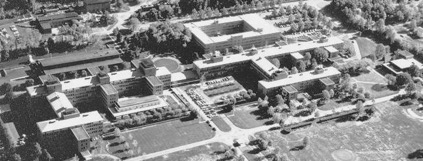Bell Labs Today:
The State of US Telecom Industry R&D

Bell Labs’ Murray Hill, NJ headquarters circa 1970 in the “golden age”
iTnews, an Australian newsletter, published a recent interview with Alcatel-Lucent CTO Marcus Weldon, “the product executive now charged with also running the famed Bell Labs”. They report that he “is perplexed as to why he was chosen to manage an organisation with a heritage in fundamental research.” As mentioned here earlier, your blogger is sentimental about his work at Bell Labs early in his career.
Weldon is quoted as saying “I'm incredibly optimistic that this is the next great era of Bell Labs. It's a little bit arrogant to state that, but on the other hand I wouldn't have taken the job if I didn't believe it were true."
The interview reveals that there are now just 700 people working at Bell Labs. By contrast, prior to 2001, Bell Labs had 11,000 employees at Chicago area locations alone! At the beginning of its existence, Bell Labs employed 4,000 individuals. In 1978, there were reportedly about 25,000 employees. Another source says the “between 1925 and 1981 the number of employees ... had grown from a little over 3,000 to 24,078.” Further that number included 3,328 with doctorates. Indeed, the Murray Hill headquarters was the center of the Bell Labs’ Research organization (as opposed to development or systems engineering which were larger and in other locations) and Research alone had 2,800 employees.
In the late AT&T monopoly era prior to Divestiture, Bell Labs was funded out from the “gross national phone bill”. I recall, but can’t find documentation for, that the pure research part of Bell Labs received something in the range of 0.5 - 1% of the gross national phone bill while the development of specific hardware and software was paid separately by the former Western Electric, the captive supplier and first choice vendor to the BOCs.
Now a great part of the size reduction of Bell Labs was because of industry restructuring and was inevitable. Much of the old Bell Labs staff was involved in development of specific new products that were then manufactured by Western Electric. In Alcatel-Lucent, divisions of A-L do their own development of products. But I have to admit that I was shocked that it is down to 700 employees. The old Nortel had a small Bell Labs-like organization and that is all gone now. But how much US-based, or even North American, industry-funded telecom research is going on now? Qualcomm clearly has a big research operation, but does anyone else?

Last summer AT&T announced that it was “opening research centers in Atlanta and Plano, Texas, part of an attempt to shed its stodgy Ma Bell image by innovating in such areas as home security, inventory tracking and in-car online services.” Further “the company also has research centers, known as foundries, in Israel and Palo Alto, California. There are 71 employees working at the foundries now, and AT&T expects that total to reach 92 by year-end. “ 92 employees - wow! Can AT&T (2012 revenue = $127.434 billion) really afford it?
An AT&T Research employee contacted me about a year ago and announced he was leaving because
“Sadly the greater leadership in AT&T have decided that internal research activities focused on physical layer technologies (current or future), is no longer in the interests of AT&T's going forward. Based on recent Lab wide meetings, the new leadership made it very clear that phy layer activities are now going to be deemphasized and the Research focus going froward will be big data, cloud and network software focused… Network technology will now likely be handed over to our vendors for development and innovations - At this recent meeting I challenged how these vendors will know what to build and plan for going forward, and aren't conferences and standards activities a very important part of that idea exchange. I was told that only standards meetings that have a direct bearing on current network activities will be supported by "AT&T representatives" and that Research shouldn't be focused on such near term actives - naturally I protested this position but it fell on "deaf ears". Worse even university and broader collaborations will be directed at network software not hardware.”
CableLabs is an example of an industry-funded R&D organization but has only “approximately 160 employees and an on-site population of visiting engineers and consultants.” Industries like the cellular industry could fund a R&D facility like CableLabs or the electric power industry’s Electric Power Research Institute, but seem to be more interested in lobbying for near term gain. (The broadcast industry’s NAB Labs might appear possibly promising, but is most likely just a PR effort from a PR-focused trade association wanting the appearance of a counterpart to CableLabs. An interview with the NAB’s CTO indicates that the main focus is testing the technology developed by others.)
To maintain US competitiveness in telecom technology, not to mention avoiding the national security implications of being totally dependent on offshore companies for all telecom infrastructure, isn’t a greater US-based R&D effort needed? Why not the EPRI model?



![Validate my RSS feed [Valid RSS]](valid-rss-rogers.png)

